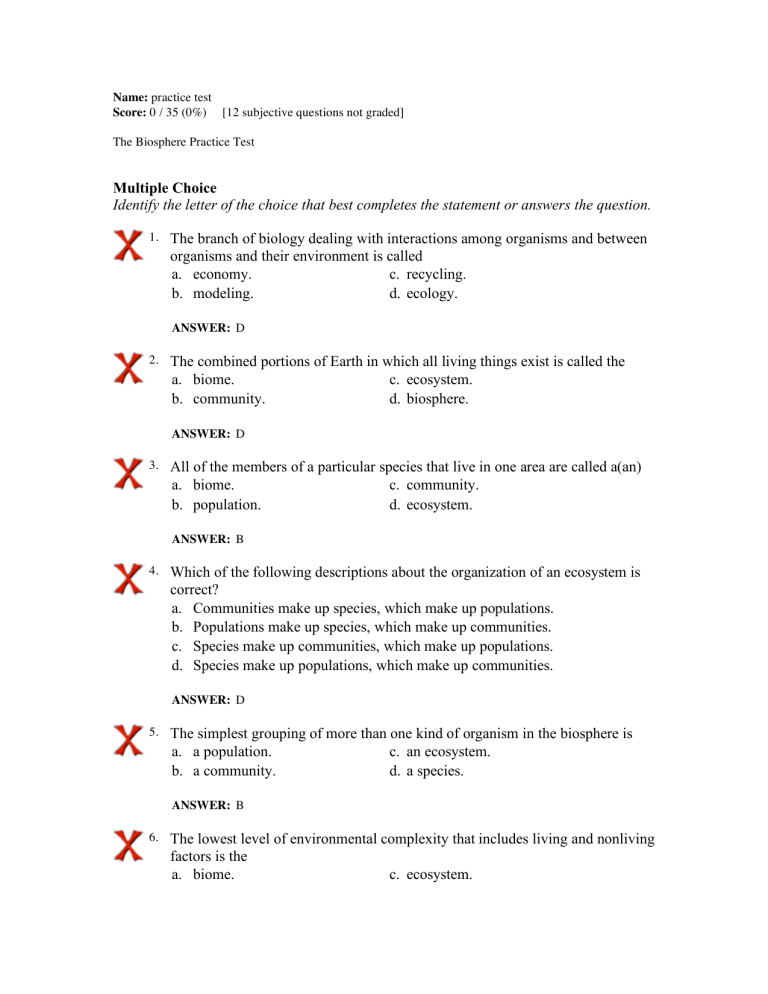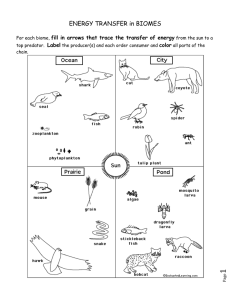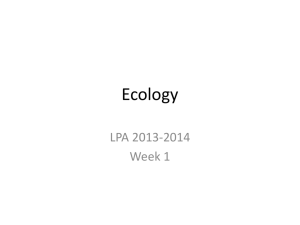Practice test answers

Name: practice test
Score: 0 / 35 (0%) [12 subjective questions not graded]
The Biosphere Practice Test
Multiple Choice
Identify the letter of the choice that best completes the statement or answers the question.
1. The branch of biology dealing with interactions among organisms and between organisms and their environment is called a.
economy.
c.
recycling.
b.
modeling.
d.
ecology.
ANSWER: D
2. The combined portions of Earth in which all living things exist is called the a.
biome.
c.
ecosystem.
b.
community.
d.
biosphere.
ANSWER: D
3. All of the members of a particular species that live in one area are called a(an) a.
biome.
c.
community.
b.
population.
d.
ecosystem.
ANSWER: B
4. Which of the following descriptions about the organization of an ecosystem is correct?
a.
Communities make up species, which make up populations.
b.
Populations make up species, which make up communities.
c.
Species make up communities, which make up populations.
d.
Species make up populations, which make up communities.
ANSWER: D
5. The simplest grouping of more than one kind of organism in the biosphere is a.
a population.
c.
an ecosystem.
b.
a community.
d.
a species.
ANSWER: B
6. The lowest level of environmental complexity that includes living and nonliving factors is the a.
biome.
c.
ecosystem.
b.
community.
ANSWER: C
7. Plants are a.
producers.
b.
consumers.
d.
biosphere.
c.
herbivores.
d.
omnivores.
ANSWER: A
8. What is the original source of almost all the energy in most ecosystems?
a.
carbohydrates c.
water b.
sunlight d.
carbon
ANSWER: B
Figure 3–1
9. The algae at the beginning of the food chain in Figure 3–1 are a.
consumers.
c.
producers.
b.
decomposers.
d.
heterotrophs.
ANSWER: C
10. An organism that uses energy to produce its own food supply from inorganic compounds is called a(an) a.
heterotroph.
c.
detritivore.
b.
consumer.
d.
autotroph.
ANSWER: D
11. An organism that cannot make its own food is called a(an) a.
heterotroph.
c.
autotroph.
b.
chemotroph.
d.
producer.
ANSWER: A
12. Organisms that obtain nutrients by breaking down dead and decaying plants and animals are called a.
decomposers.
c.
autotrophs.
b.
omnivores.
d.
producers.
ANSWER: A
13. What is an organism that feeds only on plants called?
a.
carnivore c.
omnivore b.
herbivore d.
detritivore
ANSWER: B
14. All the interconnected feeding relationships in an ecosystem make up a food a.
interaction.
c.
network.
b.
chain.
d.
web.
ANSWER: D
15. The total amount of living tissue within a given trophic level is called the a.
organic mass.
c.
energy mass.
b.
trophic mass.
d.
biomass.
ANSWER: D
16. What is an ecological model of the relationships that form a network of complex interactions among organisms in a community from producers to decomposers?
a.
food web c.
food chain b.
an ecosystem d.
a population
ANSWER: A
17. What is the term for each step in the transfer of energy and matter within a food web?
a.
energy path c.
trophic level b.
food chain d.
food pyramid
ANSWER: C
18. A bird stalks, kills, and then eats an insect. Based on its behavior, which ecological terms describe the bird?
a.
herbivore, decomposer c.
carnivore, consumer b.
producer, heterotroph d.
autotroph, herbivore
ANSWER: C
19. A snake that eats a frog that has eaten an insect that fed on a plant is a a.
first-level producer.
c.
second-level producer.
b.
first-level consumer.
d.
third-level consumer.
ANSWER: D
Figure 3–2
20. The trophic levels in Figure 3–2 illustrate a.
the relative amount of energy at each level.
b.
the amount of living organic matter at each level.
c.
the relative number of individual organisms at each level.
d.
that the producers outnumber first-level consumers.
ANSWER: C
21. In which way does Figure 3–2 differ from a typical model of trophic levels?
a.
Second-level consumers outnumber first-level consumers.
d.
First-level consumers outnumber second-level consumers.
d.
First-level consumers outnumber second-level consumers.
ANSWER: C
22. Only 10 percent of the energy stored in an organism can be passed on to the next trophic level. Of the remaining energy, some is used for the organism’s life processes, and the rest is a.
used in reproduction.
c.
stored as fat.
b.
stored as body tissue.
d.
eliminated as heat.
ANSWER: D
23. Most of the energy available to a consumer trophic level is used by organisms for a.
transfer to the next trophic level.
b.
respiration, movement, and reproduction.
c.
producing inorganic chemical compounds.
d.
performing photosynthesis.
ANSWER: B
24. Which type of pyramid shows the amount of living tissue at each trophic level in an ecosystem?
a.
a numbers pyramid c.
a biomass pyramid b.
an energy pyramid d.
a food pyramid
ANSWER: C
25. Matter can recycle through the biosphere because a.
matter is passed out of the body as waste.
b.
matter is assembled into chemical compounds.
c.
biological systems do not use up matter, they transform it.
d.
biological systems use only carbon, oxygen, hydrogen, and nitrogen.
ANSWER: C
26. The repeated movement of water between Earth’s surface and the atmosphere is called a.
the water cycle.
c.
precipitation.
b.
the condensation cycle.
d.
evaporation.
ANSWER: A
27. What is the process by which bacteria convert nitrogen gas in the air to ammonia?
a.
nitrogen fixation c.
decomposition b.
excretion d.
denitrification
b.
excretion d.
denitrification
ANSWER: A
28. Carbon cycles through the biosphere in all of the following processes EXCEPT a.
photosynthesis.
c.
burning of fossil fuels.
b.
transpiration.
d.
decomposition of plants and animals.
ANSWER: B
29. How is carbon stored in the biosphere?
a.
in the atmosphere as carbon dioxide b.
underground as fossil fuels and calcium carbonate rock c.
in the oceans as dissolved carbon dioxide d.
all of the above
ANSWER: D
30. Which of the following has a direct role in the nitrogen cycle?
a.
bacteria c.
decomposers b.
legumes d.
all of the above
ANSWER: D
31. Organisms need nutrients in order to a.
utilize hydrogen and oxygen.
c.
recycle chemical compounds.
b.
carry out essential life functions.
d.
carry out nitrogen fixation.
ANSWER: B
32. The movements of energy and nutrients through living systems are different because a.
energy flows in one direction and nutrients recycle.
b.
energy is limited in the biosphere and nutrients are always available.
c.
nutrients flow in one direction and energy recycles.
d.
energy forms chemical compounds and nutrients are lost as heat.
ANSWER: A
33. Biogeochemical cycling ensures that a.
human activity will have no effect on elements, chemical c.
nutrients will be circulated throughout the biosphere.
c.
nutrients will be circulated throughout the biosphere.
d.
many nutrients will not reach toxic concentrations in the biosphere.
ANSWER: C
Completion
Complete each sentence or statement.
Figure 3–3
34. In the water cycle shown in Figure 3–3, the process of
_________________________ occurs between evaporation and precipitation.
RESPONSE:
ANSWER: condensation
35. The water shown flowing over land in Figure 3–3 is called ____________________.
RESPONSE:
ANSWER: runoff
Short Answer
36. Describe the flow of energy among the following members of an ecosystem: decomposers, autotrophs, heterotrophs, and the sun.
RESPONSE:
ANSWER: Energy flows from the sun to the autotrophs, and from the autotrophs to the heterotrophs. Energy also flows from the autotrophs and the
36. Describe the flow of energy among the following members of an ecosystem: decomposers, autotrophs, heterotrophs, and the sun.
RESPONSE:
ANSWER: heterotrophs to the decomposers.
Figure 3–3
37. Using Figure 3–3, trace the path of water that leaves a lake through evaporation, and describe how it might return to the lake.
RESPONSE:
ANSWER: Water evaporates from the lake, condenses in the atmosphere, and falls as precipitation. Some rain may fall directly on the lake and some water may return to the lake as runoff.
38. What and where is the biosphere?
RESPONSE:
ANSWER: The biosphere is the combined portions of the planet in which all of life exists, including land, air, and water. It extends from about 8 kilometers above Earth’s surface to about 11 kilometers below the surface of the ocean.
Figure 3–1
39. Using Figure 3–1, explain the relationship between sharks and the sun.
RESPONSE:
ANSWER: Sharks are the top consumer in a food chain that begins with algae.
Algae are producers that get their energy from the sun. Energy from the sun eventually is passed on to the shark.
Other
Figure 3–2
40. Describe the flow of energy to the owl in Figure 3–2 if the tree provides 1500 calories of energy to the insects.
RESPONSE:
ANSWER: The insects would provide 10 percent (one tenth) of 1500 calories, or
150 calories, of energy to the shrews. The shrews would provide one tenth of 150 calories, or 15 calories, to the owl.
USING SCIENCE SKILLS
Figure 3–4
41. Inferring Figure 3–4 shows a food web arranged into trophic levels. How many energy-transferring steps away from the sun is the deer? How do you know?
RESPONSE:
ANSWER: The deer is on the second trophic level, so it is two steps away from the sun.
42. Inferring A food web, such as the one in Figure 3–4, is a model of the feeding relationships in an ecosystem. What makes this model representative of an ecosystem?
RESPONSE:
ANSWER: An ecosystem is a collection of all the organisms that live in a particular place, together with their nonliving, or physical, environment. A food web represents relationships among all the organisms and their environment.
43. Interpreting Graphics In Figure 3–4, how many first-level consumers are there for each producer?
RESPONSE:
ANSWER: There is one first-level consumer for corn, three for carrots, four for flowering shrubs, and one for trees.
43. Interpreting Graphics In Figure 3–4, how many first-level consumers are there for each producer?
RESPONSE:
ANSWER: There is one first-level consumer for corn, three for carrots, four for
44. flowering shrubs, and one for trees.
Comparing and Contrasting In Figure 3–4, compare the amount of energy available to the wolf if it eats only first-level consumers with the amount of energy available to the wolf if it eats only second-level consumers.
RESPONSE:
ANSWER: There is more energy available to the wolf if it eats only first-level consumers.
45. How does a food web differ from a food chain?
RESPONSE:
ANSWER: A food chain is a series of steps in which organisms transfer energy by eating and being eaten. A food web is a feeding relationship among the various organisms in an ecosystem that forms a network of complex interactions. A food web links all the food chains in an ecosystem together.
46. Describe the three types of ecological pyramids.
RESPONSE:
ANSWER: An energy pyramid is a diagram that shows the relative amounts of energy or matter contained within each trophic level in a food chain or web. A biomass pyramid represents the amount of living tissue within each trophic level. A pyramid of numbers shows the relative number of organisms at each trophic level.
47. Describe the biological significance of the carbon cycle. Where is carbon found in the biosphere?
RESPONSE:
ANSWER: Carbon is biologically significant because it is the key ingredient of all living organisms. Carbon is found in several reservoirs within the biosphere. Carbon occurs in the atmosphere as carbon dioxide gas, in the oceans as dissolved carbon dioxide, and in organisms, rocks, soil, and underground as coal, petroleum, and calcium carbonate rock.






